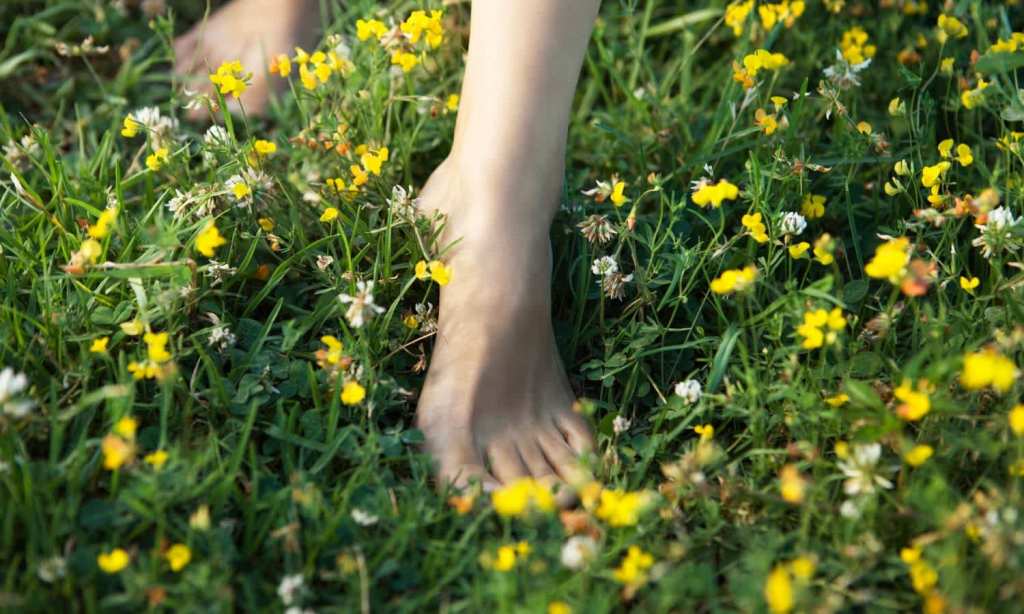Earthing — or grounding, as it’s also known — involves standing or walking barefoot in order to connect with the earth. Or, more specifically, connect with the electrical charges emitted from the earth, according to Healthline.
“The Earth’s surface is negatively charged with free electrons — meaning that the Earth has an abundance of free (negatively charged) electrons that travel and rapidly reduce positive charge,” Clint Ober, a leader in the field of grounding told mindbodygreen (mbg).
“Example: When standing barefoot on the earth, the body absorbs these free electrons and equalizes to the earth’s negative charge.”
The easiest way to practise earthing is to simply walk outside barefoot. Whether it’s on grass, sand or soil, just make sure you’re walking on a natural surface. Healthline also recommends lying down on grass or sand at the beach as it helps increase the “skin-to-earth contact”.
Otherwise, swimming in natural water is also a great option, which makes sense because how refreshed and zen do you feel after a dip in the ocean?!
While earthing is still an under-researched area, there are a few preliminary studies that show promising health benefits, especially in the areas of:
★ Anxiety and depression: A study of 40 participants analysed the technique of grounding versus “sham-grounding” (which involves no grounding at all) on mental health. The research found that “pleasant and positive moods statistically significantly improved among grounded but not sham-grounded-participants.” Participants who participated in just one hour of grounding experienced a significantly improved mood.
★ Cardiovascular disease: One study found that self-administered earthing over 12 weeks helped reduce blood pressure levels in hypertension patients. “All 10 patient measurements were found to be significantly improved at the end of the trial period, and some, well before the end. Systolic levels decreased during this time, ranging individually from 8.6% to 22.7%, with an average decrease of 14.3%.”
★ Pain and fatigue: A study in the United States studied the effects of earthing on massage therapists (who often experience health problems due to their profession). For six weeks, the therapists underwent a series of tests related to grounding. According to the study, “therapists were not grounded for the first week, were grounded while working on clients and at home while sleeping for the next four weeks, and then ungrounded for the last week.”
The results experienced by the group of massage therapists was astounding.
“As a group, therapists experienced significant increases in physical function and energy and significant decreases in fatigue, depressed mood, tiredness and pain while grounded as compared to not being grounded. At one-month following the study, physical function was also increased and depressed mood and fatigue were decreased.”
While all of these research outcomes are extremely positive, all of the studies were conducted on a small number of participants. So, future studies need to include more participants to really test the positive outcomes of earthing.
Despite the need for more research, earthing can still have a place in your health routine.
“The consensus is that it’s not curative but can be recommended within an integrative plan for mostly preventive but also therapeutic, health management,” board-certified neurologist Ilene Ruhoy, M.D., Ph.D., told mbg.
While a stroll on the beach might not be possible at the moment, standing on the grass in your backyard is just as good, says Ruhoy.
“All one needs is access to a small patch of earth,” she told mbg. “That can be in a park, on a trail, by a body of water.”
According to Ober, 30 minutes of earthing should be enough time to reap the benefits. He also recommends making the practice a mindful one.
“Make a little note before you ground listing your pain levels, describing any aches or pains and how you feel,” he told mbg. “Notice any stress, anxiety, anger, or tension in your body. Then compare the change after grounding.”







